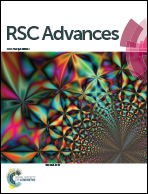Histidine-mediated synthesis of chiral fluorescence gold nanoclusters: insight into the origin of nanoscale chirality†
Abstract
Despite a significant surge in the number of investigations into chirality at the nanoscale, there is currently only limited knowledge about the chirality origin and potential applications. Here, we have succeeded in preparing a pair of gold nanocluster enantiomers, in which the histidine (His) enantiomers serve as both the reducing agent and the stabilizing ligand. Origins of the optical activity are discussed from the viewpoint of the intrinsically chiral core model and the dissymmetric field effect. The former is proposed to be responsible for the chirality origin of the as-prepared chiral gold nanoclusters (AuNCs), and both of them act concurrently for the chiroptical response observed in the ligand exchange reactions, which are performed on the His enantiomer-based clusters with enantiopure thiol Pen and Cys ligands, respectively. In addition, the clusters display potential toward biological labelling due to the high photoluminescence (PL) quantum yield and remarkable cellular uptake, in spite of the fact that no chirality-dependent effects in autophagy and subcellular localization are observed in the following fluorescence imaging.


 Please wait while we load your content...
Please wait while we load your content...